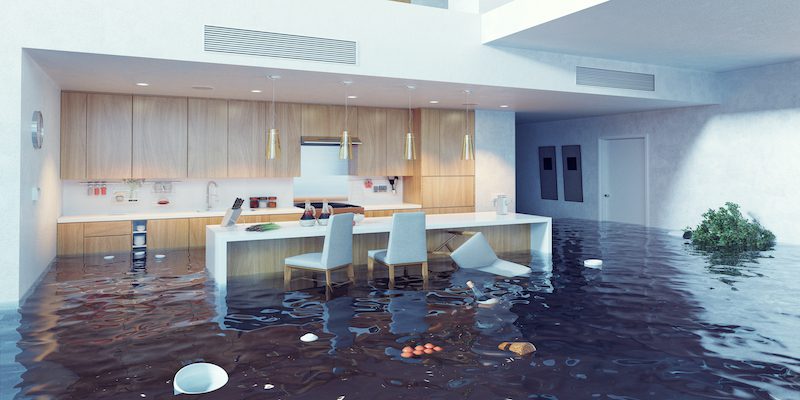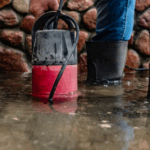When the Rains Come: 8 Flood Safety Tips for Any Homeowner

When you think of flood risk, you’re probably picturing southern states like Florida or Louisiana, where guarding against rushing water is an ingrained habit. However, what few homeowners realize is that floods are the most widespread of any weather-related natural disaster. In fact, one study found that an estimated 41 million Americans live in areas where they might be exposed to flooding, with the risk potentially rising due to climate change. In addition, according to the National Flood Insurance Program (NFIP), one in three insurance claims come from properties located in moderate-to-low risk flood areas.
As the seasonal risk of flooding rises with heavy spring rains and melting snow, here is what you should know.
1. Assess your flood risk.
First start with your baseline risk – i.e. whether your home is normally at low, moderate, or high risk. You can get started at the Flood Map Service Center hosted by the Federal Emergency Management Agency (FEMA).
Then, monitor your risk seasonally as needed and be aware of local flood watches or warnings. According to the National Weather Service:
- A flood advisory means you should be aware.
- A flood watch means you should be prepared.
- A flood warning means you should take action.
2. Store valuables properly.
Unlike most natural disasters, flood risk starts at the bottom of your house, so your first step is to move irreplaceable belongings, like important documents, photographs, jewelry, heirlooms, and other valuables to higher ground if flooding is threatened. You may even decide to relocate these items to a higher elevation permanently, given that many flood insurance policies don’t cover items stored in a basement or crawl space — any below-ground room.
3. Prepare your exterior.
Clean gutters and storm drains of debris so that water can flow freely, rather than building up. If you’re in an area that’s prone to flooding, talk to a landscaper about adjusting your slope to direct water away from your home. They also can suggest hardscape features, such as a French drain that will divert water away from the property, or a brick or concrete floodwall that can protect windows or stairwells.
Yard amenities that aren’t secured can be whisked away by floodwaters or swept toward your home, causing additional damage. Anchor heavy items like play structures and BBQs, which will make your backyard safer in any potential emergency.
4. Create a checklist of tasks if floods threaten.
If you’re not in an area prone to floods, your house might not be permanently prepared for potential flooding, so it’s important to have a plan of action should the unexpected happen.
- Tour your exterior and note which items should be relocated if a flood threatens. For example, you might want to put your patio chairs, table, and umbrella away if flooding is imminent, rather than have them permanently anchored.
- Take an inventory of your bottom floor to decide which items are most important to move upstairs if you’re on a flood warning.
- Use concrete blocks to elevate appliances.
- Turn off utilities at the main power switch and close the main gas valve.
- Make sure pets are safe and check on neighbors.
5. Double check that you have a solid emergency plan.
No matter what the potential natural disaster — hurricane, earthquake, tornado, or fire — emergency preparation will be similar:
- Have adequate provisions. (This checklist from Ready.gov covers the basics.)
- Create a communications plan with your family.
- Know how to access the most up-to-date information.
Review alternate routes that will get you to safety. - Stay safe if a flood occurs.
6. Be ready to react if your area is under a flood watch.
Here’s what to do:
- Evacuate immediately when told to.
- If you can’t get out before the waters come, stay in your home. Don’t walk, swim, or drive through flood waters, says Ready.gov.
- If you can’t safely leave, move to the highest level you can, only relocating to your roof if you must.
- Stay in your car if you’re trapped in fast-moving water, unless it is rising inside the car, in which case you should move to the vehicle’s roof.
- Avoid routes with bridges as they can easily wash away.
- Don’t underestimate the power of flood waters. The NWS cautions that six inches of rushing water can knock over an adult and just 12 inches of fast-moving water can carry away a car.
7. Stay safe after the flood.
Flood waters can leave dangerous conditions. Here’s what you should know:
- Don’t return home unless authorities have said it’s safe.
- Wear protective clothing, including boots, masks, and gloves, when cleaning up to avoid coming in contact with mold.
- Don’t wade in floodwaters as they could be contaminated or electrically charged from downed or underground power lines.
8. Make sure you have adequate coverage.
Many homeowners are surprised to find that flooding is not covered under most basic policies. While those in high-risk areas are required to have flood insurance if they have a federally backed mortgage, others need to add it as a supplemental policy. Don’t wait until it’s too late to protect your home and belongings. Now is the time to consider adding optional flood coverage — because while April showers ideally bring May flowers, they also can bring floods.
If you’re wondering whether you would benefit from a flood insurance policy, Matic makes it easy to find an affordable insurer, without having to compare policies yourself. Just answer a few simple questions and you’ll be on your way to a personalized quote.



